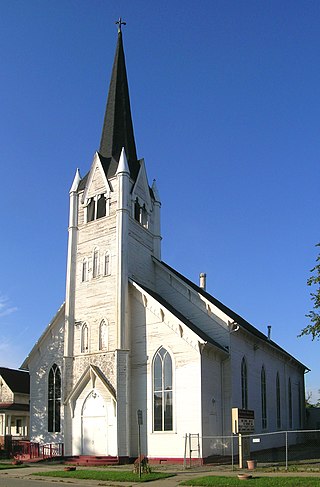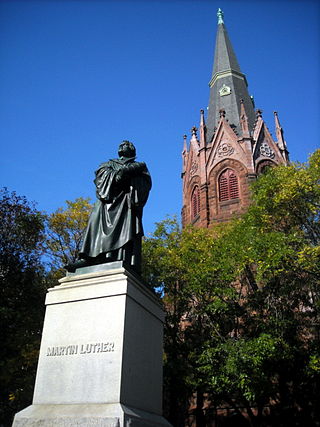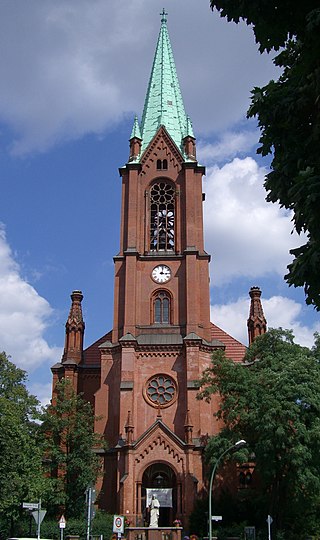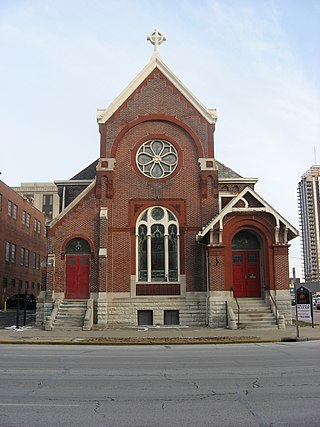
Christ Evangelical Lutheran Church is a historic church built in 1901 by a German Lutheran congregation southwest of the Walker's Point neighborhood of Milwaukee, Wisconsin. It is listed on the National Register of Historic Places.

The Deutsche Internationale Schule Johannesburg (DSJ) is a German international school in Parktown, Johannesburg.

St. John's Lutheran Church is a historic Lutheran church located at 544 Broadway NW in Knoxville, Tennessee. The church building is listed on the National Register of Historic Places, both individually and as a contributing property in the Emory Place Historic District.

The Gethsemane Evangelical Lutheran Church is a church located at 4461 Twenty-Eighth Street in Detroit, Michigan. It was designated a Michigan State Historic Site in 1980 and listed on the National Register of Historic Places in 1982. The building now houses the Motor City Missionary Baptist Church.

Luther Place Memorial Church is a congregation belonging to the Evangelical Lutheran Church in America. The neo-Gothic church building in Thomas Circle in Washington, D.C., was designed by architects Judson York, J. C. Harkness, and Henry Davis and constructed in 1873 as a memorial to peace and reconciliation following the American Civil War. Its original name was Memorial Evangelical Lutheran Church. The Luther Monument is situated in front of the church. The statue is a replica of the centerpiece of the Luther Monument in Worms, Germany, and was given to the church in 1884 by German emperor William I.

Gethsemane Church is one of four church buildings of the Lutheran Northern Prenzlauer Berg Evangelical Congregation, within the Evangelical Church of Berlin-Brandenburg-Silesian Upper Lusatia, an umbrella organisation which includes Lutheran, Reformed, and United Protestant Calvinist congregations.

St. Paul's (Zion's) Evangelical Lutheran Church is the official name of what is usually referred to as St. Paul's Lutheran Church in Red Hook, New York, United States. Its six buildings and cemetery are on a 15-acre (6.1 ha) lot on South Broadway just south of the village center. The current church is the third building on a spot that has been home to what was originally a Reformed congregation since 1796.

St. John's Evangelical Lutheran Church is a historic Lutheran church in downtown Springfield, Ohio, United States. Founded as a German-speaking parish in Springfield's early days, it grew rapidly during its first few decades, and its present large church building was constructed in the 1890s under the direction of one of Springfield's leading architects. The congregation remains in the landmark church building, which has been named a historic site.

First Lutheran in Houston is a historic Lutheran church at 1311 Holman Street in Houston, Texas. It is part of the North American Lutheran Church (NALC). The current church building was constructed in 1927 in a Lombard Romanesque style. The church building was added to the National Register of Historic Places in 2006.

Saint John's Lutheran Church is an active church building located at 121 South Locust Street in the city of Adrian in Lenawee County, Michigan. It was designated as a Michigan State Historic State on February 23, 1981 and shortly after listed on the National Register of Historic Places on December 27, 1984. The Lutheran congregation moved to a new home in 2007, and the church building now houses the Reformed Baptist Church of Lenawee.

Emmanuel's Evangelical Lutheran Church is a historic Lutheran church at 30 W. Warren Street in Germantown, Ohio. The Gothic Revival church building was constructed in 1867 for a congregation that formed in 1809. The congregation had originally shared a building with the local German Reformed congregation; when this arrangement proved inadequate in the 1830s, it built its own brick building, which was reconstructed into the 1867 building. It is one of four extant churches in the area built by Pennsylvania German settlers in the nineteenth century. The church's design features a gable front entrance split into three sections, each with an arched doorway and large arched stained glass window; the central section is topped by a tall multi-faced steeple.

Trinity Lutheran Church is a historic former Lutheran church in downtown Canton, Ohio, United States. Built in the 1880s for a flourishing congregation, it closed in the early 2010s, leaving behind a church building that has been named a historic site.

St. John's Lutheran Church, founded in 1770, is a historic Lutheran church located at 141 South Potomac Street in the South end of the arts and entertainment district of Hagerstown, Maryland.

Mount Pisgah Lutheran Church, also known in its early years as the First Lutheran Church and First English Lutheran Church and more recently as The Sanctuary on Penn, is located at 701 North Pennsylvania Street in downtown Indianapolis, Indiana. The historic church was built by the city's first Lutheran congregation, which organized in 1837, and was its third house of worship. The former church, whose present-day name is The Sanctuary on Penn, is operated as a for-profit event venue.
The Great Synagogue on Wolmarans Street, Johannesburg, is known as the city's mother synagogue and "the crown jewel of Orthodox Judaism in South Africa." All large-scale Jewish events in Johannesburg were held in the building, and throughout its existence it was the seat of the country's chief rabbi. Northward migration by congregation members led to the synagogue relocating in 1994, to be replaced by the Great Park Synagogue on Glenhove Road, Oaklands, built on the model of the Great Synagogue, whose own architecture in turn was inspired by the Hagia Sophia.
Temple Israel is the oldest of eleven Progressive synagogues in South Africa. It is a provincial heritage site, built in the Art Deco style by architect Hermann Kallenbach. It is located in the Johannesburg suburb of Hillbrow. It is an affiliate of the South African Union for Progressive Judaism (SAUPJ), which is part of the World Union for Progressive Judaism (WUPJ).
The Johannesburg East Reformed Church was a congregation of the Dutch Reformed Church in South Africa (NGK) in the Johannesburg suburb of Doornfontein, just east of downtown. It is also known as the Irene Church after the sobriquet of its second and third churches on 1 Beit Street. Five weeks before its centennial, on June 1, 1997, Johannesburg East was absorbed by the Johannesburg Reformed Church (NGK), from whence it had seceded on July 8, 1897.

The Lutheran Church of the Redeemer is a Lutheran church in midtown Atlanta, Georgia. The congregation was founded in the city in 1903, with the current building constructed in 1952.

Friedenskirche is a Lutheran church in Stuttgart, Baden-Württemberg, Germany, and the parish church of the Evangelische Friedensgemeinde Stuttgart. The first church, in neo-Romanesque style was consecrated in 1892. Destroyed during World War II, with the exception of the tower, it was rebuilt in the 1960s in concrete, and consecrated anew in 1966. The church also serves as a concert venue.



![<span class="mw-page-title-main">Christ Church, Windhoek</span> Lutheran church in Windhoek, Namibia]](https://upload.wikimedia.org/wikipedia/commons/thumb/f/f3/Kirche_Windhuk.JPG/320px-Kirche_Windhuk.JPG)














